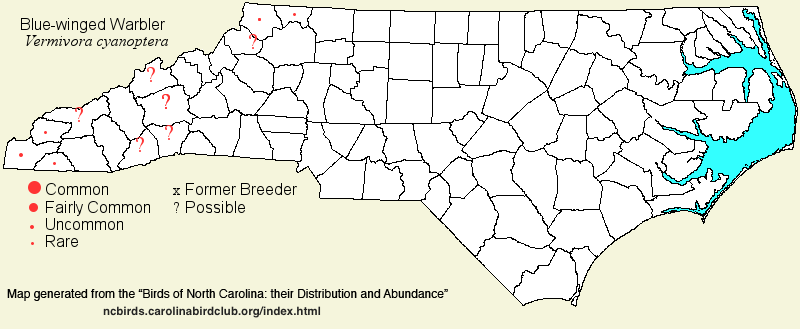 |  |
|
Blue-winged Warbler - Vermivora cyanoptera PARULIDAE Members: | Search Common: Search Scientific: |
|
|
|||||||
| General Comments |
The Blue-winged Warbler nests in the eastern United States and extreme southeastern Canada. Its nesting range lies mainly west of the Appalachians, and to the north of North Carolina. In fact, until the 1960's it was not known to occur as a breeder our state. Since that decade, birds have slowly moved into the lower mountains, mainly in the extreme southwestern counties (Cherokee and Graham, and likely Clay); however, a few birds now presumably nest in scattered other mountain counties north to Ashe. Unfortunately, our knowledge of the breeding range and population in the state has been hampered by the lack or scarcity of birders in the southwestern counties. This movement into the state has caused some concern; the very closely related Golden-winged Warbler, which is clearly declining range-wide but nests over most of the mountains, is now occasionally inter-breeding with Blue-wingeds (see below). Nonetheless, it is gratifying to see a native species starting to nest in the state, and the Golden-winged range lies primarily above (elevation) that of the Blue-winged. Away from the mountains, it migrates across the rest of the state, though a birder usually has to be afield often to see one. Breeding habitat for the Blue-winged is primarily shrub thickets or abandoned fields with shrubs or saplings, usually along streams in open country, typically in a fairly wide valley. Migrants are always seen in hardwoods, mainly in bottomlands or other fairly moist forests or thickets.
Blue-winged and Golden-winged warblers breed to produce hybrid offspring falling into two forms known as "Brewster's Warbler" and "Lawrence's Warbler". Brewster's is a first generation hybrid, and is by far more common. Lawrence's is much rarer, and is believed to be a backcross of two Brewster's Warblers, or one Brewster's with a Blue-winged or Golden-winged. Brewster's and Lawrence's warblers are fertile, unlike many hybrids, and their descendants may show varying degrees of deviation from the normal parent and hybrid forms. Habits, habitats, and dates of the hybrids are similar to those of the parent species. Both forms occur in the state in migration, and a few Brewster's have been present in the mountains in summer and have mated with Golden-wingeds. Brewster's is very rare in migration, whereas the Lawrence's is casual to very rare, and has apparently not been been reported in summer. | ||||||
| Breeding Status | Breeder | ||||||
| NC BRC List | Definitive | ||||||
| State Status | SR | ||||||
| U.S. Status | |||||||
| State Rank | S2B | ||||||
| Global Rank | G5 | ||||||
| Coastal Plain | Transient. Migrates in spring and fall across the region, but scarce. In spring, uncommon in the western portion, and rarer eastward (rare toward the coast). In fall, rare to uncommon across the region; easily overlooked in fall, as males are not singing. Mainly late Apr to mid-May, and mid-Aug to late Sep. Reports of the species in a yard in Oriental (Pamlico) in Jan, Feb, and Mar 1994 and 1995, including banded on 5 Mar 1995, defy explanation, if correct. Peak counts: | ||||||
| Piedmont | Transient. Uncommon and easily overlooked in both spring and fall (not really "rare"). Distribution across the region is probably similar from east to west. Mainly late Apr to mid-May, and late Aug to late Sep. Peak counts: | ||||||
| Mountains | Transient, scarce and decliing summer resident, though with few records of breeding evidence. In summer, rare (but formerly uncommon) in Cherokee, and apparently very rare in Graham and maybe Clay (elevations below 2,000 feet); elsewhere, very rare and local in Ashe, Buncombe, Madison, and perhaps a few other counties, essentially below 3,000 feet. Two were seen building a nest in the Norco Tract of Sandy Mush Game Land (Buncombe) on 28 May 2021. In migration, generally rare in both seasons across the region, below about 3,500 feet. Peak counts: 9 (includes a female feeding a young), Cherokee, 23 Jun 1975. Three at Sandy Mush Game Land (Buncombe) on 30 May 2010 is the best recent count of presumed breeders. | ||||||
| Finding Tips |
Perhaps a visit to Sandy Mush Game Land in late May or early June could produce a sighting, as might driving back roads in Cherokee, stopping often, or driving slowly with the car window down. The "Beeeee-buzzzz" song can be heard easily from a slowly-moving car. ** | ||||||
| Attribution | LeGrand[2024-11-08], LeGrand[2023-04-03], LeGrand[2021-09-04] | ||||||
| NC Map Map depicts all counties with a report (transient or resident) for the species. | Click on county for list of all known species. |
| NC Breeding Season Map Map depicts assumed breeding season abundance for the species. |  |